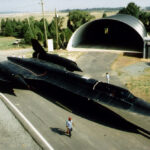Got tiny flying bugs bothering you in your kitchen? You might have fruit flies! Don’t worry, these common pests are easy to deal with, and you probably have everything you need to get rid of them right in your home. We recently had a fruit fly issue ourselves – the first time in years! So, I took it as a chance to test out 7 different ways to eliminate them. Yes, I kept notes and even used a spreadsheet. Today, I’m sharing the best homemade fruit fly traps and how to make them.
These DIY traps are simple to create using natural ingredients you likely already have. They’re extremely DIY-friendly and chemical-free. If you prefer a humane approach, you can even release the trapped fruit flies outside. We’ll also cover how to prevent fruit fly problems in the first place.
What Exactly Are Fruit Flies?
Fruit flies are small, flying insects that are attracted to ripe fruits and vegetables, just as their name suggests. They’re also drawn to sugary or fermenting drinks like beer, wine, and juice. You’ll often see them buzzing around fruit bowls, garbage cans, and even kitchen sinks. They are about the size of a grain of rice and look like small, tan or brownish houseflies with distinctive red eyes. They are most common in late summer and fall when fruits are in season.
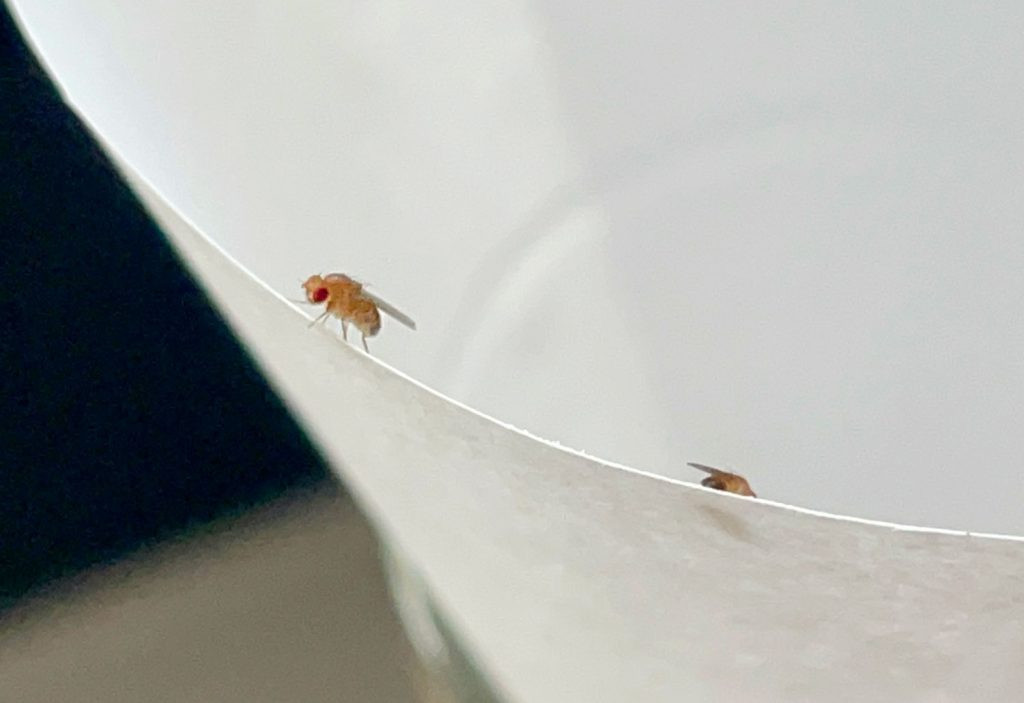 Close Up Of Fruit Fly On Paper Funnel
Close Up Of Fruit Fly On Paper Funnel
A fruit fly problem often starts when a few flies sneak into your home on fruits or vegetables. But female fruit flies can lay hundreds of eggs in their short lifespan, and these eggs can hatch in as little as 12 hours. They become adults in just days, meaning a small number of fruit flies can quickly turn into a large infestation. That’s why it’s important to act fast and get rid of them as soon as you notice them.
Fruit Flies, Fungus Gnats, and Drain Flies: Spotting the Difference
Fruit flies are often mistaken for other common household pests, especially fungus gnats and drain flies. All three are small flying insects, but knowing how to identify them correctly is key to choosing the right elimination method. The easiest way to tell them apart is by where you see them and what larger insect they resemble.
- Fruit flies look like tiny flies. They are typically found near fruit bowls, trash cans, and other food sources with a sweet or fermenting smell.
- Drain flies look like small, fuzzy moths. You’ll usually find them around sinks and drains.
- Fungus gnats look like small mosquitos. They are usually found near houseplants because they breed in damp potting soil.
If you’re unsure which pest you’re dealing with, try one of the traps below. If it attracts the pests in your home, you’ve likely got fruit flies!
4 Simple DIY Fruit Fly Trap Recipes
Getting rid of fruit flies doesn’t have to be difficult or expensive. You just need a few common household items and a little patience. Each trap works on the same principle: attract the fruit flies and then prevent them from escaping. We tested these 4 DIY methods and found a clear winner. However, since you probably already have the supplies for each method, it’s worth trying more than one. It’s actually kind of fun to become a fruit fly scientist – trust me! Here are the first 4 methods I tried:
- Funnel Trap
- Plastic Wrap Trap
- Dish Soap Trap
- Rotting Fruit Trap
I’ll share more details about each method below, and our results at the end. Keep in mind that some traps work faster than others, and it might take a few days to completely solve your fruit fly problem.
DIY Fruit Fly Trap #1: The Paper Funnel Trap
This trap lures fruit flies into a container through a small opening at the bottom of a paper funnel. The flies can get in, but they struggle to get back out through the narrow opening.
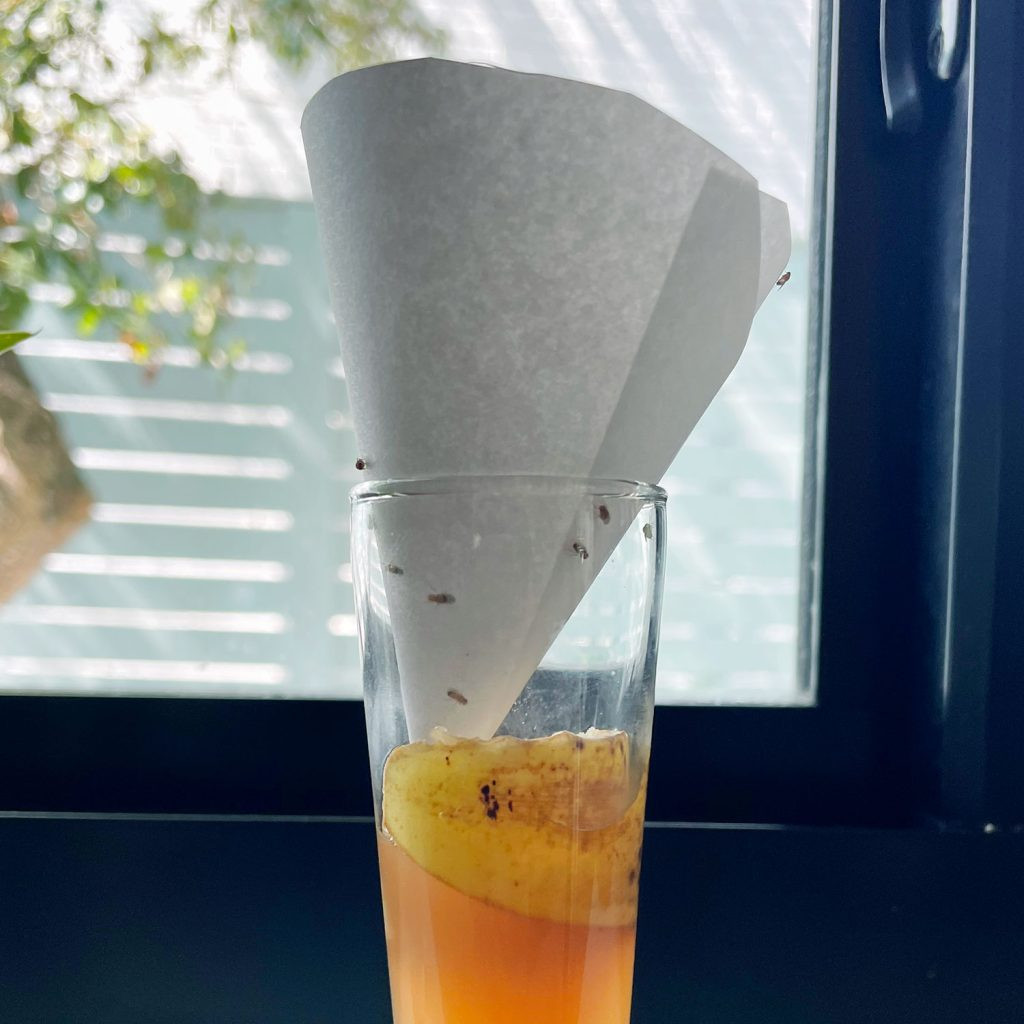 DIY Fruit Fly Trap With Paper Funnel
DIY Fruit Fly Trap With Paper Funnel
Supplies you’ll need:
- Small clear jar, cup, or container (preferably with a narrow opening)
- Piece of paper or cardstock
- Tape
- Scissors
- Apple cider vinegar (ACV)
Instructions:
- Choose your container. Find a small, clear container like a clean food jar or plastic bottle. A narrow opening works best for this trap.
- Add the lure. Pour a small amount of apple cider vinegar, old beer, or wine into the bottom of the container. The sweet, fermented smell will attract the fruit flies.
- Make the paper funnel. Roll a piece of paper or cardstock into a cone shape with a very small opening at the tip. Secure the cone with tape. You can cut the small opening at the tip if it’s easier. It only needs to be about the size of a grain of rice.
- Set up the funnel. Place the paper funnel into the opening of your container. You might need to adjust the shape of the funnel so it sits securely on top of the container opening without touching the liquid. Make sure it fits snugly against the edges so flies can’t escape through any gaps.
- Humane Release (Optional). To release the trapped fruit flies outside, carefully carry the entire trap outdoors without disturbing the funnel (or they’ll fly out!). Then, remove the funnel and let them fly away.
You can also use a store-bought funnel, but the opening might be too wide, allowing fruit flies to escape more easily.
DIY Fruit Fly Trap #2: The Plastic Wrap Trap
This trap also uses the enticing smell of apple cider vinegar to attract fruit flies. They enter through tiny holes poked in the plastic wrap covering the container but then get trapped inside.
Supplies you’ll need:
- Small clear jar, cup, or container
- Rubber band
- Plastic wrap or a plastic bag
- Toothpick
- Apple cider vinegar (ACV)
Instructions:
The steps for this plastic wrap trap are very similar to the funnel trap.
- Choose your container. Select a small, clear jar, cup, or glass container. Almost anything will work, and it doesn’t need to be large. A clear container makes it easier to see the trapped flies, but even an old soda or beer can will do.
- Add the bait. Pour apple cider vinegar into the container. The smell is what attracts them. Old beer or wine also works, but regular white vinegar is not as effective.
- Cover with plastic wrap. Tightly stretch plastic wrap over the opening of the container and secure it with a rubber band. Saran wrap works well, or you can cut a piece from a plastic bag.
- Poke small holes. Use a toothpick to poke a few small holes in the plastic wrap. You don’t need many, just enough for a fruit fly to get through.
- Humane Release (Optional). Carefully take the trap outside without removing the plastic wrap (or the flies will escape!). Once outside, remove the plastic wrap to let them fly away.
You can also make this trap using a metal jar lid. Use a mason jar or an old food jar with a metal lid. Puncture a small hole in the lid using a hammer and nail.
DIY Fruit Fly Trap #3: The Simple Dish Soap Trap
This fruit fly trap is different because it doesn’t require a cover. Instead, it uses the surface tension of soapy water to trap the flies. Note: Fruit flies trapped in this method won’t be able to be released as they get coated in soap.
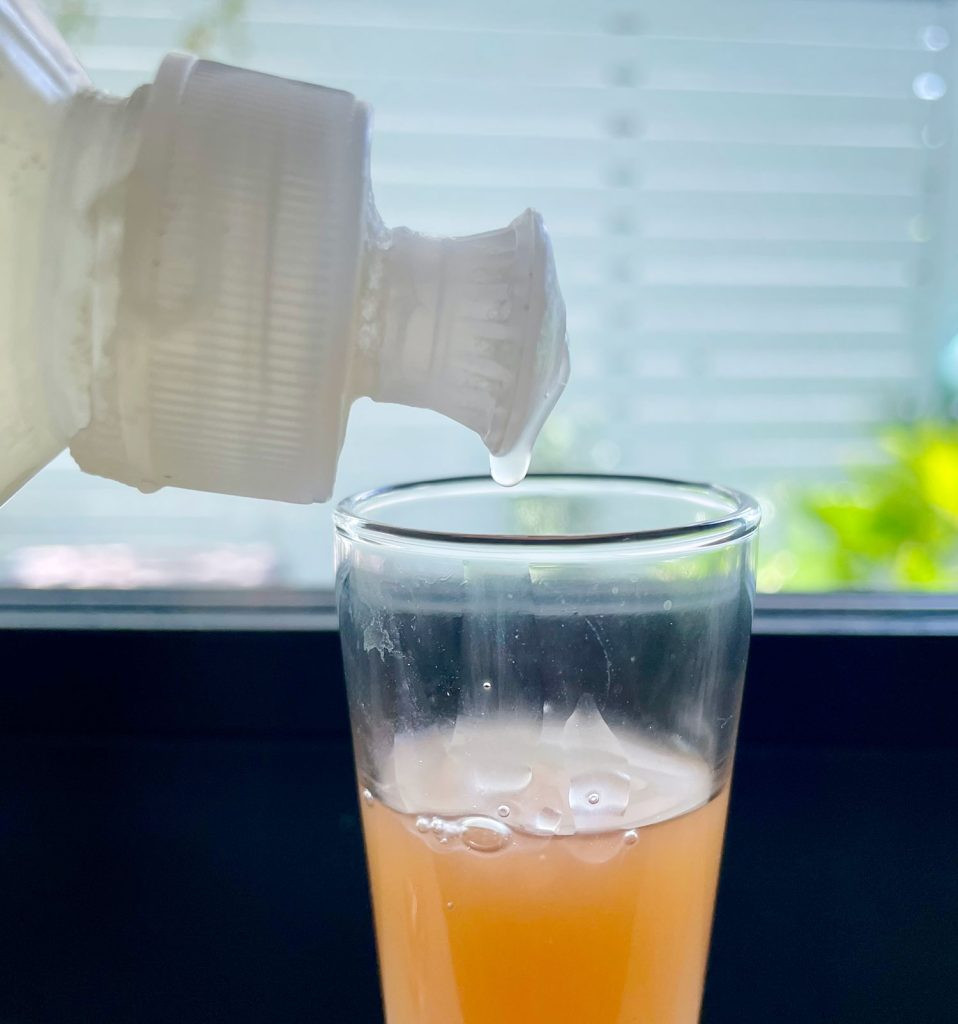 Dripping Dish Soap Into Apple Cider Vinegar For DIY Fruit Fly Trap
Dripping Dish Soap Into Apple Cider Vinegar For DIY Fruit Fly Trap
Supplies you’ll need:
- Small container, bowl, or dish
- Dish soap
- Apple cider vinegar (ACV)
Instructions:
This trap is incredibly easy to make.
- Pour in apple cider vinegar. Just like the other traps, pour a bit of apple cider vinegar into the bottom of a small container, bowl, or dish. The scent will attract the fruit flies.
- Add dish soap and mix. Add several drops of dish soap to the apple cider vinegar and gently mix it. The soap breaks the surface tension of the liquid, so when fruit flies land on it, they will sink and get trapped.
You can also combine this dish soap method with the plastic wrap or funnel traps. Just add a few drops of dish soap to the apple cider vinegar before covering the top. This provides an extra way for the flies to get stuck.
DIY Fruit Fly Trap #4: The Rotting Fruit Trap
We also tested traps using what fruit flies love most: actual fruit!
Supplies you’ll need:
- Small glass jar, cup, or container
- Plastic wrap or paper funnel (depending on the trap you choose)
- A small piece of ripe fruit, like a banana peel or apple slice
Instructions:
To make a rotting fruit trap, simply replace the apple cider vinegar with a piece of banana peel, apple slice, or peach in either the Plastic Wrap Trap or Funnel Trap. You can also add a piece of fruit to your apple cider vinegar trap for an even stronger lure. Remember to replace the fruit every day or two to avoid unpleasant smells in your kitchen.
The Most Effective Fruit Fly Trap: Our Verdict
As you can see in the photos, we tested 4 different DIY traps to see which worked best. The homemade traps we tested were:
- Plastic Wrap Trap with banana peel
- Funnel Trap with ACV + banana peel
- Plastic Wrap Trap with ACV + dish soap
- Dish Soap Trap with ACV
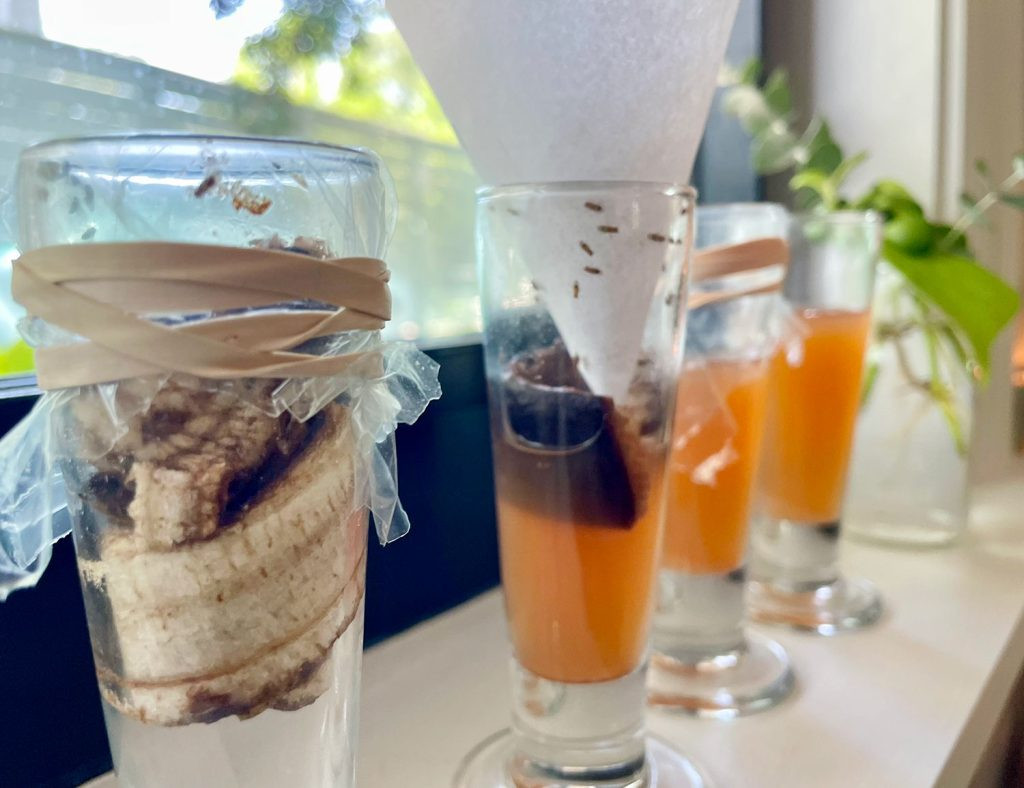 4 DIY Fruit Fly Traps Close Up
4 DIY Fruit Fly Traps Close Up
For us, the most important factor wasn’t the type of trap, but the bait. Traps with banana peel worked significantly better than those using only apple cider vinegar. Our two Plastic Wrap Traps were almost identical, but the one with banana peel caught dramatically more fruit flies than the one with ACV and soap. Perhaps apple cider vinegar is less appealing when real fruit is nearby?
Our recommendation is to add a piece of fruit to any trap you set up! We slightly preferred the plastic wrap trap because it was easier to make and less likely to be accidentally knocked over. I accidentally bumped the funnel trap once and let many flies escape back into the kitchen – oops!
What is the Best Bait to Attract Fruit Flies?
This is where I saw an opportunity to continue my fruit fly experiment. Since fruit scraps worked so well, we wanted to test which type of fruit was the most effective bait. We tested three fruits we had on hand: banana peel, apple slices, and a strawberry. We put each in a Plastic Wrap Trap, side-by-side on our counter, for 24 hours.
While the banana peel started out strong (it was the ripest at the beginning), fruit flies were most attracted to the strawberry. The banana peel still caught a good number of flies, but the riper the strawberry became, the more flies it trapped. The apple slices didn’t catch a single fruit fly!
Store-Bought Fruit Fly Traps: Are They Worth It?
If DIY traps aren’t working for you, or if you prefer a ready-made solution, there are commercial fruit fly traps available. Many have thousands of positive reviews and cost under $20. They might be a good option if you want a trap that catches other types of flying insects or prefer something less visible than a DIY trap.
 Collage of Storebought Fruit Fly Traps
Collage of Storebought Fruit Fly Traps
During our experiment, I bought a pack of Terro Fruit Fly Traps to compare them to my homemade traps. I placed one next to our banana and strawberry traps for 24 hours to see which performed best.
Again, our homemade strawberry trap performed best, closely followed by the banana peel trap. The store-bought trap only caught one fruit fly. HOWEVER…
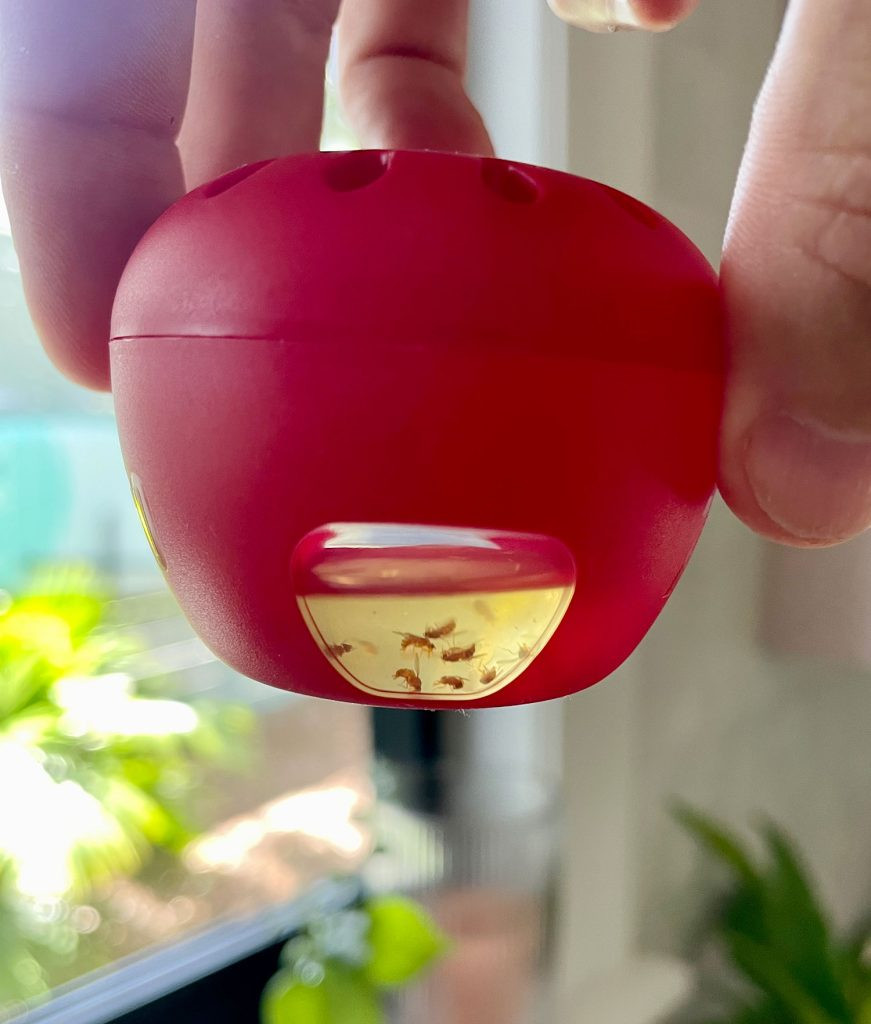 Terro Fruit Fly Trap With Dead Fruit Flies Visible
Terro Fruit Fly Trap With Dead Fruit Flies Visible
To be sure, we removed our DIY traps and left the store-bought trap out for another 24 hours. That’s when it caught the number of flies you see above. So, store-bought traps definitely work, just not as quickly or effectively as our homemade traps. Our conclusion? Use store-bought traps if you want something more discreet, especially for long-term use. But for fast and effective fruit fly removal, homemade traps are the best way to go!
How to Prevent Fruit Flies: Simple Tips
Getting rid of fruit flies is easy, but preventing them in the first place is even better. Here are some simple steps to keep fruit flies from invading your home:
- Keep kitchen surfaces clean. Wipe down counters, stovetops, tables, and any surfaces that might have food residue or spills. Fruit flies are especially attracted to fruit, sugary drinks, and alcohol, so clean up spills right away!
- Take out the trash regularly. Food scraps in your garbage can become a breeding ground for fruit flies very quickly, especially in warmer weather.
- Dispose of overripe fruit promptly. Check your fruit bowl regularly for overripe or rotting fruit and discard it before it becomes a problem.
- Wash fruits and vegetables when you bring them home. Washing produce immediately (except for berries, which can spoil faster with moisture) can remove any fruit fly eggs or larvae that might be on the surface.
- Store produce in the refrigerator when possible. Fruit flies don’t thrive in cold temperatures, so refrigerating fruits and vegetables is a good preventative measure.
- Clean your sink drain regularly. Food particles in your sink drain can also attract fruit flies. Run your garbage disposal and/or flush the drain with hot water regularly.
Finally, don’t panic if you see fruit flies in your home. Yes, you should take action quickly to prevent a larger infestation. But the DIY solutions in this article are easy, effective, and fast-acting. You might even enjoy becoming a fruit fly scientist like I did!
*This post contains affiliate links, so we may earn a small commission when you make a purchase through links on our site at no additional cost to you.
